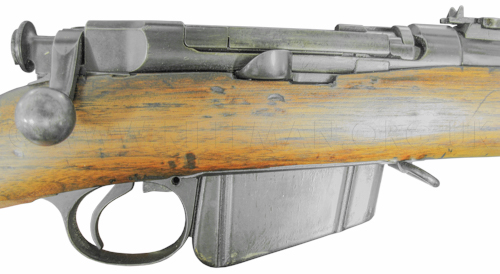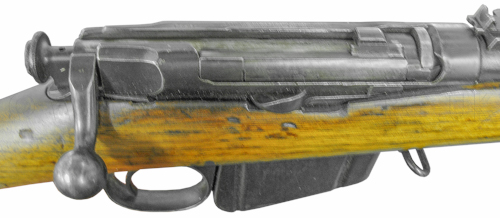
Please be aware that some specialist imagery may take time to load.
This site is designed for dedicated researchers on desktop or tablet, not ideal for mobile browsing.
See also: the 'Long' Lee-Metford a & Lee-Enfield Magazine Rifles.
Held in the Small Arms School Collection at Warminster
and originally one of the 1887 trials rifles.
Click on the image for a higher resolution photograph.
James Paris Lee was Scottish born in 1831, but emigrated with his family to Canada at about the age of five.
Apprenticed in horological work, his fine engineering skills were highly honed, allowing him to start his own business.
In 1858 he moved his new and expanding young family to Wisconsin, in the U.S.A.,
where he followed his personal interest in firearms design, working particularly on the development of a repeating rifle.
He produced a successful conversion of a Springfield rifle from muzzle-loader to breech-loader,
and had some of his early designs prototyped by the Sharps Rifle Co.,
but became directly involved with the Remington Arms Company, with whom he worked for many years,
although also setting up his own Lee Firearms Company in Milwaukee,
being contracted to produce his Springfield rifle conversions during the American Civil War.
Another of Lee's interests took him into the area of typesetting and printing,
leading him to make recommendations, to other involved colleagues,
that assisted in the design of what became the Remington typewriter.
Lee's design for his now famous and long-lasting bolt-action was patented in 1877,
and his first production rifle, manufactured at the Remington factory, sold to the U.S. Navy and worldwide.
It was this rifle's design that eventually bore fruit to the 1885 British trials rifle shown on this page.

The magazine is particularly recognisable as the predecessor of those of the Lee-Metford and Lee-Enfield rifles.

The rifle incorporates a bolt with two rear horizontally opposed locking lugs, and its fine repeating action
replaced the obsolete single-shot falling-block Martini-actioned rifle of the British forces.
The Remington-Lee underwent gruelling trials, and proved a thoroughly tough and robust rifle;
a worthy replacement for the Martini rifles,
and it was from this rifle that the Lee-Metford Magazine Rifle was to devolve.
The switch from black-powder to Cordite propellant in 1892, might have rendered the Lee action no longer of use,
but its inherent strength was so good that it stood up perfectly well to the increased pressures;
this factor meant that the action was a perfect match for the new square-edged rifling
of the freshly designed Enfield barrel that was to replace the sine-wave cross-section of the outgoing Metford rifled barrels.
The World was now ready for the 1903 introduction of what was to prove one of the longest-serving military long-arms ever devised -
- the Rifle, Short, Magazine Lee-Enfield - or 'SMLE', ( widely known as the "Smellie").
To paraphrase a piece written by the then curating officer of the Small Arms School Collection -
- and displayed there with the above rifle:
"Other rifles have come and gone, changes have been made, but born out of the Remington-Lee is that most famous bolt-action rifle, the .303 Lee Enfield No.1. It has been lightened and shortened, and subjected to the firing of grenades and grappling hook lines, but James Lee's patented bolt action was not yet finished. It continued life with the Lee-Enfield Rifle No.4, which trialled as the No.1 Mk.VI Rifle in 1936, and the very same action was proved to be tough and strong enough to handle the pressure and forces of the new 7.62mm NATO cartridge in 1971. This saw the old Lee-Enfield sniper rifle, now called the L42A1, built on the actions of the WW2 No.4T Sniper Rifles, serving for another 20 years as the standard sniper rifle of the British Army, including during the Falklands War ........... and it's STILL barely finished, because tucked away in armouries all over the country, awaiting disposal - having giving sterling service over seventy years - until only very recently, are the little Lee-Enfield No.8 training rifles, only just replaced by the L144A1 Cadet Small-bore Rifle."
And from whence does the new Cadet Rifle hail? Canada, of course!
And as a final note:
"The Warminster SASC Collection holds one particular SMLE No.1 rifle (catalogue no.3114), serial number B-2805, which is the LAST full bore .303" rifle in service with the British Army, having been on charge since 1955 until struck off charge in 2009.
From the battlefields of Le Cateau to the Somme, to El-Alamein, Burma, Korea and Malaya,
it's been there, done that, seen the film, AND got the T-shirt."
"THANK YOU ............... AND A BIG HAND FOR JAMES PARIS LEE"
See also: the Long Lee-Enfield adapted for early WWI Royal Flying Corps aerial use.
See also: other Experimental and Trials Lee-Enfield Rifles
Return to: TOP of PAGE
See this website's Raison d'être